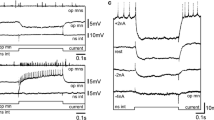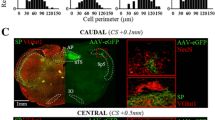Summary
-
1.
Stretch applied to the ventricle, or contraction of the heart, sets up afferent activity (presumably of a sensory nature), in the cardiac nerve ofBusycon canaliculatum. Such afferent activity, elicited by either mechanical or electrical stimuli, can be traced through the pseudoganglion, the cardiac nerve, and the visceral ganglia to the parietal-visceral connectives.
-
2.
In response to the induced afferent activity, efferent activity appears and can be recorded from a teased-out intracardiac branch of the cardiac nerve.
-
3.
Section of the cardiac nerve distal to the visceral ganglia may lead to an increase in amplitude of compound peaks in the extra- or intraventricular cardiac nerve.
-
4.
Electrical activity ceases in the intraventricular branches of the cardiac nerve, after severing the cardiac nerve distal to the pseudoganglion.
-
5.
The pseudoganglion is possibly a reflex center for the intraventricular branches of the cardiac nerve, but there is an inhibitory central influence on the reflexes. The inhibitory influence is probably exerted by the visceral ganglia.
Similar content being viewed by others
References
Carlson, A. J.: Comparative physiology of the invertebrate heart. I. The innervation of the heart. Biol. Bull.8, 123–170 (1905)
Carlson, A. J.: Vergleichende Physiologie der Herznerven und der Herzganglien bei den Wirbellosen. Ergebn. Physiol.8, 371–462 (1909)
Hill, R. B., Welsh, J. H.: Heart, circulation and blood cells. In: Physiology of mollusca, vol. II, p. 125–174 (ed. Wilbur, K. M., Yonge, C. M.). New York and London: Academic Press 1966
Koester, J., Mayeri, E., Liebeswar, G., Kandel, E. R.: Cellular regulation of homeostasis: Neuronal control of the circulation inAplysia. Fed. Proc.32, 2179–2187 (1973)
Kuwasawa, K.: Transmission of impulses from the cardiac nerve to the heart in some molluscs (Aplysia and Dolabella). Sci. Rep. Tokyo Kyoiku Daigaku B13, 111–128 (1967)
Kuwasawa, K., Hill, R. B.: Neural Control of myocardial rhythmicity inBusycon canaliculatum. Biol. Bull.139, 427 (1970)
Kuwasawa, K., Hill, R. B.: Interaction of inhibitory and excitatory junctional potentials in the control of a myogenic myocardium: the ventricle ofBusycon canaliculatum. Experientia (Basel)28, 800–801 (1972)
Kuwasawa, K., Hill, K. B.: Regulation of ventricular rhythmicity in the hearts of prosobranch gastropods. In: Neurobiology of invertebrates, Tihany 1971, p. 143–165. Budapest: Akadémiai Kiadó, 1973a
Kuwasawa, K., Hill, R. B.: Junctional potentials in molluscan cardiac muscle. Life Sci.12, 365–372 (1973b)
Kuwasawa, K., Matsui, K.: Postjunctional potentials and cardiac acceleration in a mollusc (Dolabella auricula). Experientia (Basel)26, 1100–1101 (1970)
Mackay, A. R., Gelperin, A.: Pharmacology and reflex responsiveness of the heart in the giant garden slug,Limax maximus. Comp. Biochem. Physiol.43 A, 877–896 (1972)
Mayeri, E., Kupfermann, I., Koester, J., Kandel, E. R.: Neural coordination of heart rate and gill contraction inAplysia. Amer. Zool.11, 667 (1971)
Neal, H., Kuwasawa, K.: Afferent activity in the neural control of the heart ofBusycon canaliculatum. Biol. Bull.145, 448 (1973)
Rijlant, P.: L'automatisme du coeur des Gastéropodes:Fulgur carica etFulgur canaliculatu;Polynices. C. R. Soc. Biol. (Paris)108, 1150–1152 (1931)
Ransom, W. B.: On the cardiac rhythm of invertebrate. J. Physiol. (Lond.)5, 261–341 (1884)
S.-Rózsa, K.: Characterization of the feed-hack system in the heart ofHelix pomatia L. Ann. Biol. Tihany39, 29–38 (1972)
S.-Rózsa, K., Salánki, J.: Single neurone responses to tactile stimulation of the heart in the snail,Helix pomatia L. J. comp. Physiol.84, 267–279 (1973)
Author information
Authors and Affiliations
Additional information
This research was supported by a grant, 2 RO1 NS08352-04 PHY from the National Institutes of Health.
Rights and permissions
About this article
Cite this article
Kuwasawa, K., Neal, H. & Hill, R.B. Afferent pathways in the innervation of the ventricle of a prosobranch gastropodBusycon canaliculatum . J. Comp. Physiol. 96, 73–83 (1975). https://doi.org/10.1007/BF00611963
Received:
Issue Date:
DOI: https://doi.org/10.1007/BF00611963




